Hurricane season in Tampa Bay runs from June 1 through November 30. Peak activity usually hits between mid-August and mid-October.
Tampa Bay homeowners deal with some tricky challenges, like coastal flooding, winds that can top 150 mph, and debris flying around that can really wreck a house if you’re not ready.
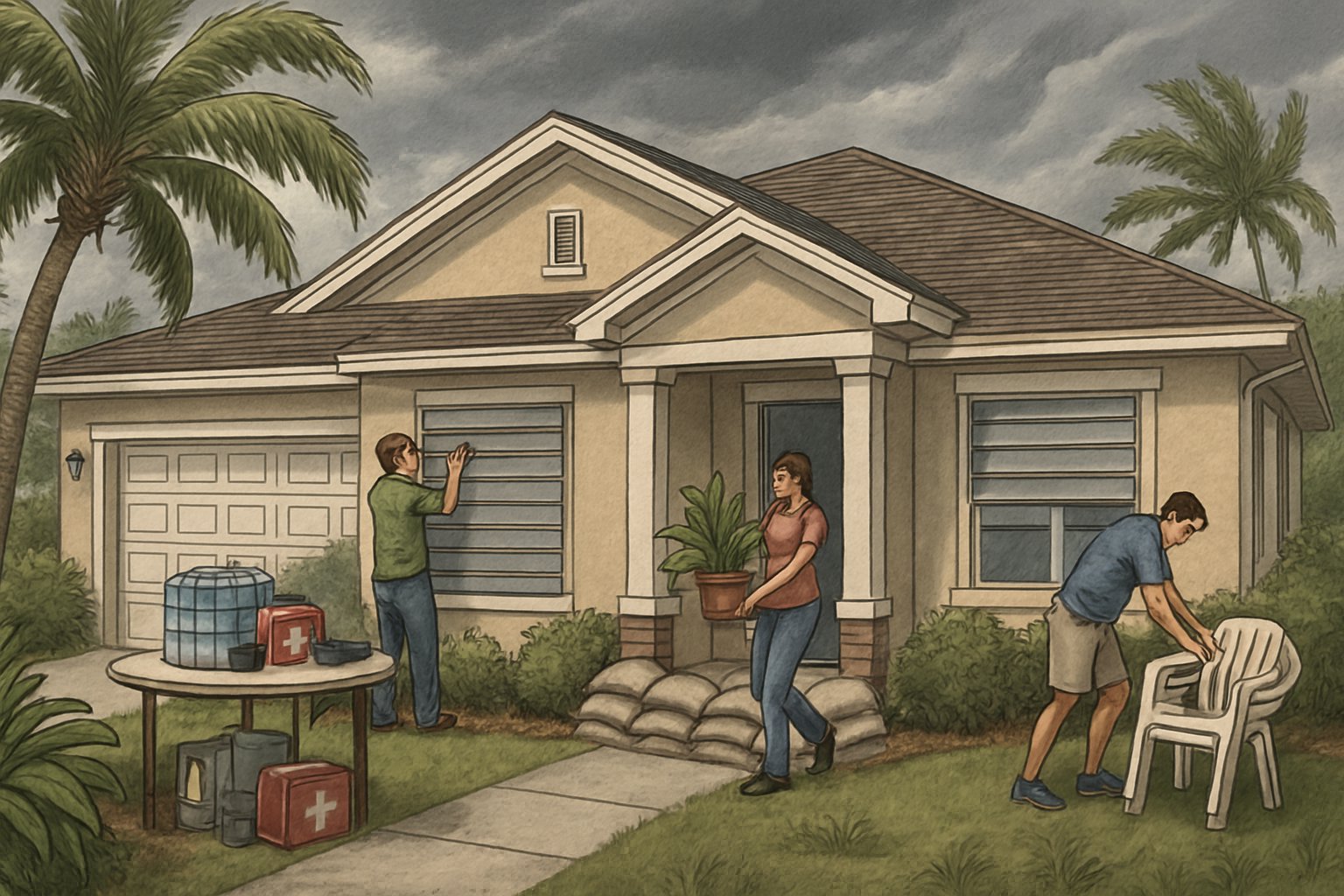
Proper hurricane prep means you’ve got to secure windows and doors, clear out gutters, stock up on emergency supplies, and have a real evacuation plan—ideally before storms start popping up on the radar.
Lots of Tampa Bay residents wait until a storm’s coming before they do anything, but that just leads to packed stores, empty shelves, and panicky choices that aren’t safe.
Need a Home Fix – Emergency or Routine?
From leaks and no-heat nights to simple tune-ups, our 24/7 hotline connects you with trusted local pros in minutes.
If you take care of things during the calm months, you’ll be able to keep your head when a storm’s actually coming. No one wants to be the person fighting for the last pack of batteries, right?
Key Takeaways
- Hurricane season peaks between mid-August and mid-October, so it’s smart to get ready well ahead of time.
- Prep essentials: reinforce windows and doors, tie down or put away outdoor stuff, and keep drainage systems clear.
- Build your emergency kit and make an evacuation plan—then check them every so often so you’re not caught off guard.
Understanding Hurricane Season in Tampa
Tampa deals with hurricane threats from June through November every year. Late summer brings the highest risk, and the city’s spot on the coast means it’s exposed to big winds, flooding, and storm surge.
When Hurricane Season Begins and Ends
Officially, hurricane season in Tampa runs from June 1st to November 30th. That’s the six months when the Atlantic’s most likely to churn up storms.
June 1st rolls around every year, and that’s when everyone starts paying more attention to the weather. Weather pros picked that date since storms before June are rare.
November 30th is the official finish line, but, honestly, storms sometimes sneak in even after that. December hurricanes aren’t common, but they do happen.
It’s smart for Tampa folks to stay ready the whole season. Even the early and late storms can do a number on houses and neighborhoods.
The National Hurricane Center watches every tropical blip during these months. They’ll send out warnings if anything looks like it’s heading toward Tampa Bay.
Peak Months and Local Risks
August through October is when Tampa’s most likely to get hit. Florida’s biggest hurricanes almost always show up during this stretch.
September, in particular, is notorious for hurricane action. Most storms hit their stride around then, at least according to the records.
Tampa’s got its own set of problems during hurricane season:
- Storm surge flooding—especially in coastal neighborhoods
- High winds that can mess up roofs and windows
- Heavy rain causing street flooding
- Power outages that might last for days or longer
Being right on Tampa Bay makes storm surge a bigger threat. Water can rise 6-10 feet above normal in a major hurricane. That’s a lot of water, fast.
Low-lying spots are at the most risk for flooding, and anyone in an evacuation zone should be ready to get out if a big storm’s coming.
How Hurricanes Impact Tampa
Hurricanes usually hit Tampa homes in three main ways. First, wind tears up roofs, siding, and windows. Then, water gets in wherever it can.
Storm surge is the worst for flooding. It pushes ocean water inland and can drown a whole neighborhood in just a few hours.
Recent storms have made it clear Tampa’s got some vulnerabilities. Damage bills often climb into the millions for the area.
Common hurricane impacts include:
- Roof shingle loss and structural damage
- Broken windows from flying debris
- Flooded basements and first floors
- Downed power lines and long outages
City infrastructure takes a hit, too. Roads flood, bridges shut down, and emergency crews can only do so much when things get bad.
Recovery times really depend on the storm. Some hurricanes just cause a few days of headaches, but the big ones can leave folks picking up the pieces for months.
Assessing Your Home’s Vulnerabilities
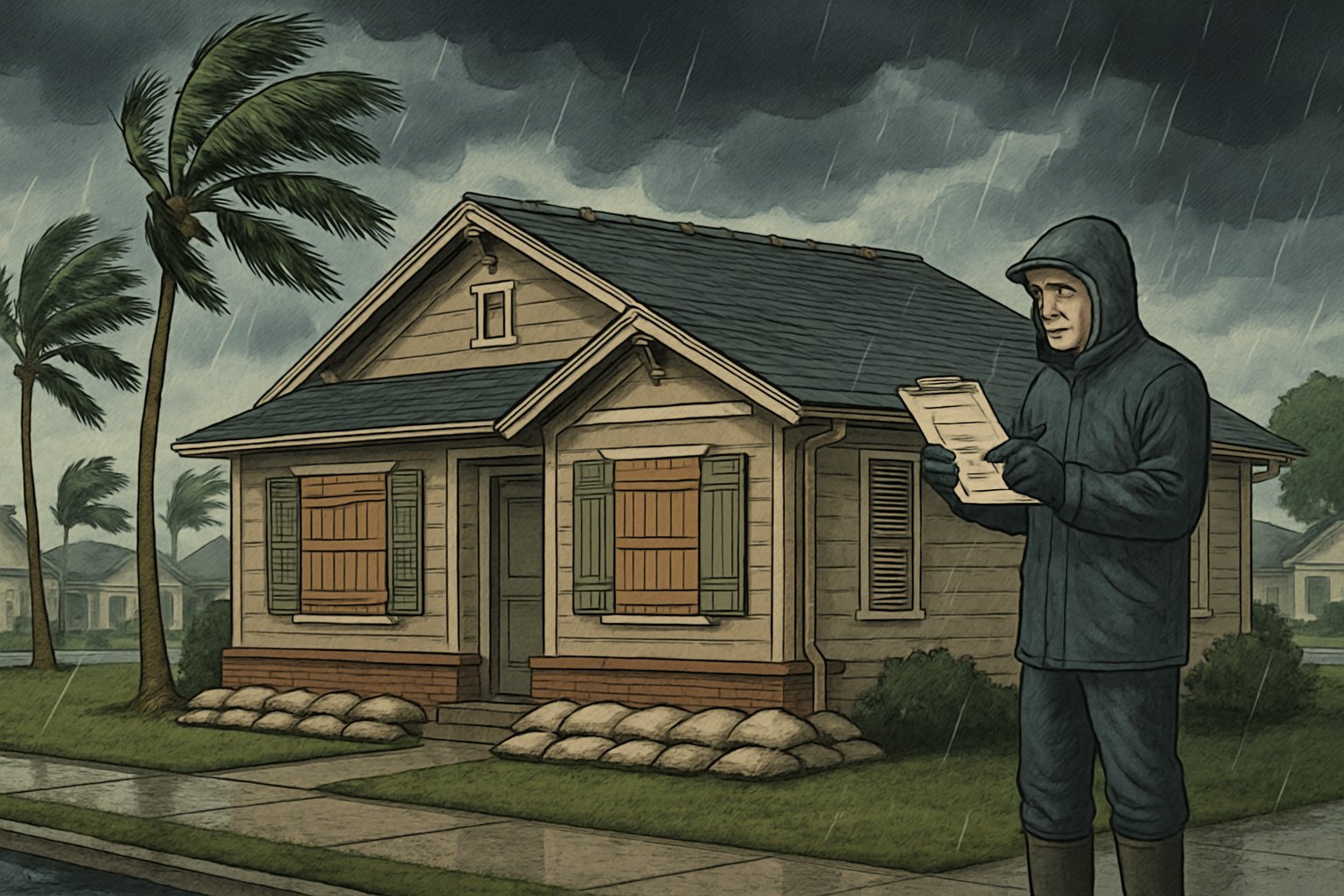
Spotting weak points in your house helps you focus your hurricane prep. With Tampa Bay’s salty air, high winds, and storm surge, you’ve got to pay special attention.
Identifying Weak Points in Your Structure
Older homes—especially those built before modern codes—are most at risk. If your place went up before 1992, it might not have hurricane straps or reinforced joints.
Key Structural Areas to Examine:
- Roof-to-wall connections—look for hurricane straps or clips
- Foundation attachments—watch for cracks at the base
- Load-bearing walls—check for any damage or weakness
- Garage doors—big openings are pressure points in storms
Gable end walls need a close look. These triangle-shaped sections often fail first in big winds. Walk around your place and see where different materials meet—those are weak spots.
If you’re not sure what to look for, a pro inspection costs $300-500. Licensed inspectors know exactly where to check and can tell you if your house can handle 140 mph winds.
Evaluating Roof, Windows, and Exterior Doors
Your roof’s probably the most exposed part of the house. Grab some binoculars and scan for shingles that are curling, cracked, or missing.
Critical Roof Components:
- Flashing around chimneys and vents
- Gutters and downspouts
- Soffit and fascia boards
- Skylights or anything else poking through the roof
Peek in your attic for water stains or daylight coming through. If you see either, you’ve already got leaks that could get worse in a storm.
Windows and doors are entry points for wind and water. Open and close every exterior door—make sure they seal tight. Gaps around frames or busted weatherstripping are red flags.
Window Assessment Checklist:
- Check the glass for cracks and see how thick it is
- Make sure frames are sturdy and attached well
- Look for storm shutters or impact ratings
- Pay special attention to big glass areas like sliders
Single-pane windows and old aluminum frames don’t offer much protection. Impact-resistant windows or storm shutters are way more reliable against flying debris and pressure shifts.
Protecting Windows, Doors, and Openings
Windows and doors are the weak spots when hurricanes come through. Adding shutters, reinforcing doors, or upgrading to impact-resistant stuff gives you a much better shot at keeping your house intact.
Installing Hurricane Shutters
Hurricane shutters shield regular windows from flying debris and high winds. They’re a must-have in storm season.
Accordion shutters stay attached outside your house. When a storm’s coming, you just fold them shut—super fast, especially for a whole row of windows.
Storm panels are cheaper. Aluminum or steel panels bolt over windows before each storm, then you stash them in the garage the rest of the year.
Roll-down shutters are the most convenient. They run on a crank or motor and go down in minutes, but they’re pricier up front.
If you’re in a bind, plywood works in a pinch. Use 5/8-inch exterior plywood, cut it to size, pre-drill holes, and label each piece so you’re not scrambling when the wind picks up.
Reinforcing Garage and Entry Doors
Garage doors fail all the time in hurricanes. They’re huge and catch wind like a sail. If your garage door blows in, wind can rip the roof right off.
Standard garage doors need reinforcement kits—these come with horizontal braces you install every two feet across the door. They keep the door from caving in.
Wind-rated garage doors can take winds up to 150 mph. They’ve got thicker panels and beefier hardware, which really helps protect the whole house.
Entry doors should have solid cores and tough frames. Check that the hinges use long screws that bite into wall studs. If you’ve got hollow doors, swap them for solid wood or metal.
Look over door frames for gaps or loose spots. Seal any openings with caulk or weatherstripping. Even tiny cracks can let wind pressure build up inside.
Upgrading to Impact-Resistant Options
Impact-resistant windows mean you don’t need to mess with shutters or plywood. They use two glass layers with a plastic film in between, so if something breaks the glass, it still holds together.
These windows meet Florida’s strict codes for coastal places. They fend off debris flying at crazy speeds and even cut down on UV and noise all year.
Impact doors work the same way. They’ve got reinforced glass and stronger frames—French doors and sliders especially benefit from these upgrades.
They cost more than just adding shutters, but you don’t have to do anything before storms. Plus, they bump up your home’s value and might lower your insurance bill.
Always check for certification. Look for labels showing Miami-Dade County standards—they’re some of the toughest out there.
Preparing the Exterior of Your Property
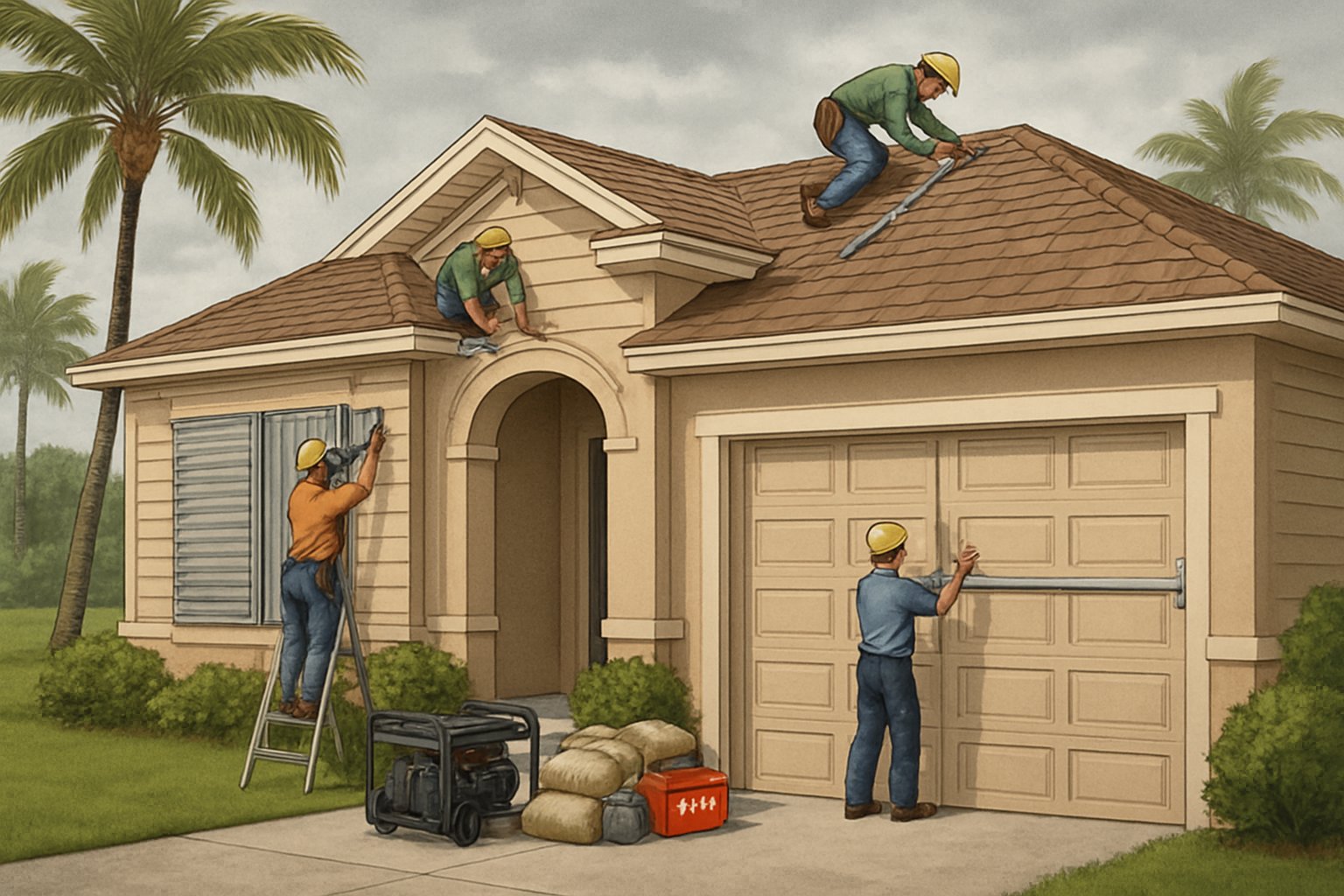
Most hurricane damage in Tampa comes from strong winds and debris. You can cut your risk by trimming trees, tying down loose stuff, and keeping drainage working right.
Trimming Trees and Shrubs
Dead or weak branches turn into airborne hazards in a hurricane. Cut any branches hanging over your roof or within 10 feet of your house.
Focus on these spots:
- Branches touching the house—trim anything that touches walls, windows, or the roof
- Dead or diseased wood—get rid of it all, since it snaps easily in wind
- Overhanging limbs—cut back branches over driveways, walkways, or your neighbor’s place
If you’ve got big trees close to the house, call a pro arborist. They can spot weaknesses you might miss.
Remove any palm fronds that are brown or hanging loose. Leave the healthy green ones—they help the tree flex with the wind.
Prune shrubs and small trees so they’re less bushy. Dense foliage catches wind and makes it more likely they’ll get ripped out of the ground.
Securing Outdoor Furniture and Items
Hurricane winds can turn patio furniture into dangerous missiles. Anything under 100 pounds might go airborne if winds hit 75 mph or more.
Items to secure or store:
- Patio furniture and umbrellas
- Grills and outdoor cooking equipment
- Potted plants and decorations
- Trash cans and recycling bins
- Garden tools and hoses
- Pool equipment and toys
Leave heavy things like concrete planters outside if they weigh over 200 pounds. Lighter decorations? Just put them in the garage or a shed.
Always remove and store patio umbrellas. That fabric turns into a sail and can wreck the umbrella or even your neighbor’s stuff.
If you have a pool, gather up loose equipment. Take out diving boards, ladders, and cleaning gear so nothing turns into a projectile.
Cleaning Gutters and Drains
Clogged gutters cause water to back up and mess up roofing materials. Heavy hurricane rains easily overwhelm blocked drains, leading to flooding.
Check gutters for these common problems:
- Leaves and debris blocking water flow
- Loose or damaged gutter sections
- Downspouts disconnected or clogged
- Missing gutter guards or screens
Clear out all debris from gutters and downspouts. Run water through with a hose to make sure everything flows right.
Look at storm drains near your place. Pull out leaves, trash, or anything clogging the openings. Clear drains help keep street flooding away from your home.
Make sure downspouts send water at least 6 feet from the foundation. Pooling water next to the house can cause flooding or even foundation trouble during big storms.
Emergency Supplies and Essential Kits
Having the right emergency supplies before hurricane season can really make a difference. Tampa folks should put together a solid list, stock up on medical stuff, and get ready for days without power or water.
Building an Emergency Supplies List
Every Tampa household needs enough supplies for at least 72 hours on their own. That’s usually how long it takes for help to arrive after a hurricane.
Water is the big one. Store one gallon per person per day for three days. A family of four? You’ll want 12 gallons in clean containers.
Food supplies need to be non-perishable and easy. Canned foods, peanut butter, crackers, and energy bars are all good. Don’t forget a manual can opener.
Essential items include:
- Battery-powered or hand-crank radio
- Flashlights and extra batteries
- Portable phone chargers
- Cash in small bills
- Important documents in waterproof containers
- Medications for at least one week
- Personal hygiene items
- Clothes and blankets
Pet owners should grab extra food, water, and supplies for their animals. Keep pets’ vaccination records and meds handy.
Stocking a First Aid Kit
A well-stocked first aid kit can make a real difference if medical help can’t get to you. Store it in a waterproof container and make sure it’s easy to grab.
Basic medical supplies should include:
- Adhesive bandages in different sizes
- Sterile gauze pads and medical tape
- Antiseptic wipes and antibiotic ointment
- Pain relievers like ibuprofen or acetaminophen
- Thermometer
- Scissors and tweezers
- Disposable gloves
Prescription medications need extra care. Keep a seven-day supply of all daily meds in the kit, in their original bottles with current labels.
Don’t forget special medical gear for any family member—like inhalers, blood sugar monitors, or mobility aids.
Preparing for Power and Water Outages
Long outages are pretty common after hurricanes in Tampa. Plan for several days without electricity or running water.
Power backup options include portable generators and battery packs. Always run generators outside to avoid carbon monoxide. Battery-powered fans can help with the heat.
Water storage isn’t just about drinking. Fill bathtubs and big containers before the storm for cleaning and washing up. Water purification tablets are handy if you’re not sure about water quality.
Food preservation gets tricky without a fridge. Use coolers with ice for essentials, and eat perishable foods first before they spoil.
Write down important phone numbers. Sometimes cell towers work even when the power’s out, but you’ll need to charge your phone with battery packs or in the car.
Developing a Hurricane Preparedness and Evacuation Plan
Every Tampa Bay resident should know their evacuation zone and have a plan for leaving or staying put. The trick is to figure all this out before a storm is even on the radar.
Knowing Your Evacuation Zone
Tampa Bay uses color-coded zones to show storm surge risk. You can find yours on the Hillsborough County emergency management site or through local government resources.
Zone A has the highest storm surge risk and evacuates first during most hurricane threats.
Zones B through E evacuate as needed, depending on the storm’s strength and surge predictions. Zone E folks usually only leave for the biggest storms.
Mobile homes and manufactured housing always get evacuation orders, no matter the zone. They just can’t handle hurricane winds safely.
Write down your zone and keep it with your important papers. It’s smart to know the zones of friends and family too, especially if they might need help.
Creating an Evacuation Plan
A good evacuation plan covers several routes out of the area. Interstate 75 and I-4 are the main roads, but they clog up fast.
Transportation planning means keeping your car fueled and in good shape. Find alternate routes on local roads in case highways get jammed.
Destination planning is about picking a spot before a storm shows up. Options include:
- Hotels inland or out of state
- Friends or family outside evacuation zones
- Public shelters if there’s nowhere else
Pet planning is a must—find pet-friendly places in advance. Most public shelters only take service animals, not pets.
Pack go-bags with essentials for every person and pet. Keep these bags ready all hurricane season.
Hunkering Down Safely
Folks in higher zones sometimes stay home during weaker storms. If you do, prep carefully and pick a safe room.
Safe rooms should be inside, away from windows, and not under big trees. First-floor bathrooms, closets, or hallways usually work best.
Store enough water, food, and meds for at least seven days. Power can be out for weeks after a big storm.
Have a battery-powered radio and portable phone chargers ready. Don’t count on cell towers—they sometimes go down.
Don’t stay in flood-prone spots or mobile homes. And if officials issue evacuation orders, don’t try to ride out a major storm at home.
Post-Hurricane Recovery and Next Steps
After the hurricane, safety comes first. Homeowners need to check for hazards, document damage, and follow the right steps for repairs and utility restoration.
Assessing Home Damage Safely
Don’t enter a damaged property until you’re sure it’s safe. Standing water and electrical systems can be deadly.
Immediate Safety Checks:
- Look for structural damage to walls, roof, and foundation
- Watch for downed power lines near the house
- Stay away from areas with standing water or flood damage
- Be alert for gas leaks or weird smells
Wait for officials to say it’s safe before heading back in. Sometimes emergency crews limit access to certain neighborhoods.
Professional Inspections Required:
- Call structural engineers for foundation or frame damage
- Get licensed electricians if water touched your electrical system
- Use plumbers for water line damage or contamination
Take photos of all damage from different angles before moving anything. That way, you’ll have what you need for insurance and contractor estimates.
Documenting Losses for Insurance
Good documentation speeds up insurance claims. Make detailed records of damage and losses.
Documentation Steps:
- Photograph everything—get wide shots and close-ups
- Write lists—describe damaged items and estimate their value
- Save receipts—keep records of temporary repairs and living costs
- Contact insurance right away—file claims within the required window
Sort damaged stuff by category: structure, personal property, and contents. Adjusters want clear evidence showing before and after the storm.
Keep documentation copies in more than one place. Digital backups can save you if paperwork gets lost.
Restoring Utilities and Repairs
Utility restoration follows strict safety steps. Power companies won’t reconnect service to flood-damaged homes until inspections are done.
Electrical System Requirements:
- A licensed electrician must check any system exposed to floodwater
- Power stays off until you get professional clearance
- Tampa Electric customers need to submit Form E-268 for service restoration
- Send completed forms to the utility before reconnection
Repair Priorities:
- Emergency repairs—use tarps or quick fixes to stop more damage
- Water removal—get rid of standing water and start drying things out
- Structural repairs—fix foundation or frame damage first
- Interior restoration—replace damaged drywall, floors, and fixtures
Properties in FEMA flood zones face extra rules. If repairs cost more than half the home’s value, the whole place needs to meet current flood standards.
Always check contractor licenses before hiring. Unlicensed contractors can cause more headaches than they solve.
Frequently Asked Questions
Tampa homeowners have a lot of questions about hurricane prep. Here are some answers about securing homes, supplies, timing, and evacuation.
What steps should homeowners take to secure their property ahead of a hurricane?
Start by checking windows and doors for leaks or weak spots. Re-seal any gaps to keep water out.
Install hurricane-rated windows and doors if you can. Storm shutters add another layer against flying debris.
Reinforce doors with heavy-duty bolts. Take a look at the roof—replace missing shingles or fix damage.
Clean gutters and downspouts so water drains properly. Trim tree branches near the house to cut down on falling debris risk.
Can you provide a comprehensive checklist for hurricane preparedness specific to the Tampa area?
Secure all outdoor items like patio furniture and decorations. Fill bathtubs and containers with clean water for emergencies.
Stock up on flashlights, batteries, and a battery-powered radio. Get enough non-perishable food for at least three days per person.
Keep first aid kits and prescription meds handy. Cash in small bills is useful if cards don’t work.
Protect important documents in waterproof containers. Test your generator ahead of time to make sure backup power is ready if you need it.
How can residents in Tampa fortify their homes against potential hurricane damage?
Installing impact-resistant windows goes a long way in protecting against hurricane-force winds. These windows can take a beating from flying debris and wild pressure swings during storms.
Roof reinforcement matters too. Secure loose shingles and check the roof’s structure for weak spots.
Metal roof straps? They’re not glamorous, but they help keep the roof attached to the house when the wind gets wild.
Crawl space waterproofing keeps flooding damage at bay beneath the home. Sump pumps can quickly move water out of places it doesn’t belong.
Garage doors need bracing so wind can’t sneak in and build up pressure inside. That kind of pressure can literally lift roofs right off houses.
What are the critical supplies to stock up on in anticipation of hurricane season in Florida?
Water tops the list—one gallon per person per day, aiming for at least a week’s supply. Non-perishable foods like canned goods, crackers, and peanut butter are your friends when the power’s out.
A battery-powered or hand-crank radio keeps you in the loop if the lights go out. Stash a few flashlights and a pile of extra batteries too; you’ll thank yourself later.
First aid kits and at least a week’s worth of prescription meds should be ready to go. A manual can opener is a must when the power’s down and you’re staring at a pile of cans.
Plastic sheeting and duct tape can patch up broken windows in a pinch. Bleach comes in handy for purifying water if things get really dicey.
During which months should Tampa residents be most vigilant about hurricane preparation?
Hurricane season hits from June 1 through November 30 every year. August through October usually bring the most action for Florida.
Honestly, August is the best time to make sure your home is ready and supplies are stocked. Waiting longer? You’re playing with fire.
September is the real danger zone for hurricanes in the Atlantic. Tampa folks face the highest risk then, so it’s no time to slack off.
October still packs a punch before the season finally slows down. Stay prepared all the way through these months—just in case.
What is the recommended evacuation plan for Tampa homeowners in case of a hurricane threat?
Tampa residents really should know their evacuation zone before hurricane season even starts. These zones decide when and where you need to get out.
There are several evacuation routes, and honestly, you’ll want to try them out before a real emergency. It’s one way to avoid sitting in endless traffic when everyone’s trying to leave at once.
If you’ve got pets, you’ll need to hunt down pet-friendly shelters or hotels ahead of time. Regular shelters usually turn away animals, which always feels a bit unfair, but that’s the reality.
Don’t forget your important documents—insurance papers, IDs, medical records. Keep them in something waterproof and grab them on your way out.
It’s smart to keep your gas tank full during hurricane season. Trust me, waiting until the official evacuation order means you’ll be stuck in a line at the gas station, probably wishing you’d planned ahead.
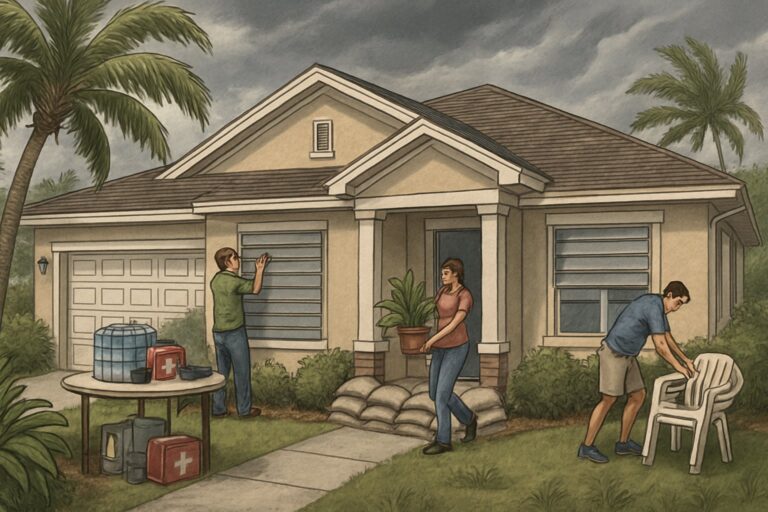
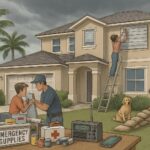
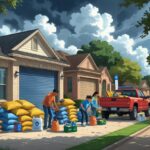



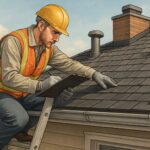
Leave a Reply